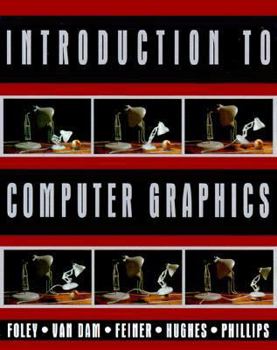Introduction to Computer Graphics
The revised edition of this introductory text on computer graphics has been reduced in length by half. Its presentation of key concepts is geared to students and provides worked examples in C. This description may be from another edition of this product.
Format:Hardcover
Language:English
ISBN:0201609215
ISBN13:9780201609219
Release Date:January 1993
Publisher:Addison-Wesley Professional
Length:632 Pages
Weight:2.50 lbs.
Dimensions:1.2" x 7.7" x 9.5"
Customer Reviews
5 ratings
Brilliant! A Must-Have! Alert the Pulitzer Committee!
Published by Thriftbooks.com User , 14 years ago
Prof. Phillips has taken an outdated, somewhat stilted text (Computer Graphics: Principles & Practice) and turned it into a masterpiece - extremely informative and helpful while remaining accessible and enjoyable to read. Highly recommended for anyone and everyone interested in computer graphics.
A must have book for every 3d programmer out there!
Published by Thriftbooks.com User , 24 years ago
Are you tired of spending hours of your time searching for 3d documentation on the net? Are you tired of searching for books? Are you tired of spending $50 on a book only to find out that it doesn't cover any of the subjects you were hoping for? Introduction to Computer Graphics covers every aspect of 3d theory to get any beginner started. It is true that some of the math requires more than high school education, but that didn't stop me when I read it in 9th grade. And if I can understand it, pretty much anybody can. If a person reads this book straight through, he not only will learn nothing but will have wasted his time too. Why? Well, half the book is full of mathematical equations and formulas. The author basically thinks like this: I supply you with the formulas and why they work, you figure out how to put it in your program. Although I'm not trying to attack the way the author wrote the book and a lot of his formulas come with C++ code, there's some stuff he doesn't explain like: HOW TO PUT IT ALL TOGETHER! A book like this could be classified as an excellent source of reference. The reason that this book stands out from all the rest is that information isn't hidden in the words. It's all straightforward explanations and formulas with a lot of graphics to reinforce the reader's knowledge. Also at the end of each chapter the author gives you a number of exercises to do for those people out there that got too much time on their hands. All together I loved it and I learned a LOT of valuable information.
The Bible which ALL 3D Programmers NEED
Published by Thriftbooks.com User , 25 years ago
This is the 3D programmers bible for 3D graphics. It is far from a breeze to read as the nature of the beast is not an easy subject.One of the most wonderful things about this book is that it supplies an extensive bibliography about each subject covered.It isn't a "how to" for DirectX or OpenGL it's more of a "here are the equations" for 3D in pretty much every aspect.You have to have it.You don't? Buy it!Expect to brush up on your maths tho! (unless yur a math head :) )Regards,Ian
Outstanding intro to both 2D and 3D graphics
Published by Thriftbooks.com User , 25 years ago
There are plenty of equations and theory for the mathematician, but even better for folks like me (hackers), there is a nice sprinkling of C code and example images. If you need the most comprehensive reference, go with the unabridged version ("Computer Graphics: Principles and Practicies", all 1175 pages of it!), but if you are looking for an introduction, I would recommend this book.
Very good book for a beginner 3d coder!
Published by Thriftbooks.com User , 26 years ago
This new introductory text to computer graphics is an adaptation of Computer Graphics: Principles and Practice,Second Edition, which remains the most comprehensive and authoritative work in the field. While retaining the currency and accuracy of the larger book, this abbreviated version focuses on topics essential for all beginners in computer graphics and provides expanded explanations for readers with little or no technical background. Worked examples have been added to illustrate important concepts and techniques, and program code has been written in the C language to enhance the book's usefulness. In addition, the book contains an extensive illustration program, with more than 50 full-color images. This book authored by James D. Foley, Andries van Dam, Steven K. Feiner, John F. Hughes, and Richard L. Phillips and is an adaptation of the "Computer graphics : principles and practice". I give this book a rating of 10 for obvious reasons. Take a look at the FULL table of contents at this link: http://heg-school.aw.com/cseng/authors/foley/intr grafix/intrografix.toc.html This is the trimed down Table of Contents (Note: At the end of each chapter the book gives you extra exercises as well as a summary) 1. Introducing: Computer Graphics 2. Programming in the Simple Raster Graphics Package (SRGP) 3. Basic Raster Graphics Algorithms for Drawing 2D Primitives 4. Graphics Hardware 5. Geometrical Transformations 6. Viewing in 3D 7. Object Hierarchy and Simple PHIGS (SPHIGS) 8. Input Devices, Interaction Techniques, and Interaction Tasks 9. Representation of Curves and Surfaces 10. Solid Modeling 11. Achromatic and Colored Light 12. The Quest for Visual Realism 13. Visible-Surface Determination 14. Illumination and Shading Bibliography Index This book features : Adaptation of the definitive computer graphics book in the field--half the length. Presents key concepts geared toward students with minimal technical background. Provides worked examples in C. Retains the high level of teaching standards of the parent graphics text.




